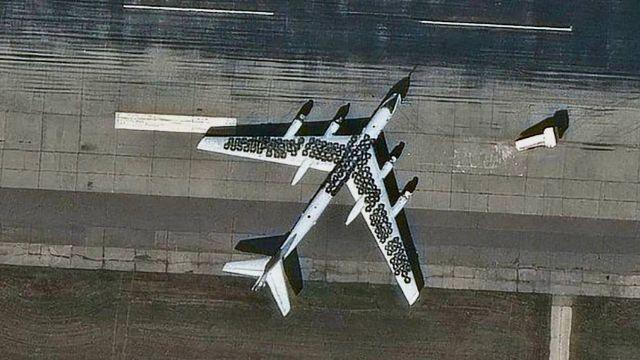On June 5, 2025, Russian Deputy Foreign Minister Sergey Ryabkov announced that the strategic bombers damaged in a Ukrainian drone attack on June 1 will be repaired, dismissing reports of their destruction.

Speaking to the state-run news agency TASS, Ryabkov emphasized, “The equipment in question, as representatives of the Ministry of Defense have already stated, was not destroyed but damaged. It will be repaired.”
His statement comes in the wake of a bold and unprecedented Ukrainian operation that targeted Russian air bases deep within the country, raising questions about the extent of the damage and Russia’s ability to restore its critical military assets.
The attack, which struck airfields hosting Russia’s strategic aviation, has sparked debates about its impact on Moscow’s military capabilities and its nuclear deterrence strategy.
The Ukrainian drone assault on June 1 was a meticulously planned operation that caught Russian defenses off guard. Dubbed “Operation Spiderweb” by Ukrainian officials, the attack targeted multiple military airfields, including those in Murmansk, Irkutsk, Ivanovo, Ryazan, and Amur regions, some located thousands of miles from the Ukrainian border.
Ukrainian forces employed small, cost-effective first-person-view [FPV] drones, which were reportedly smuggled into Russia and launched from mobile platforms, such as trucks disguised with makeshift wooden structures.
According to reports from Ukrainian media, including UNIAN, the operation was prepared over 18 months under the direct supervision of President Volodymyr Zelenskyy. The audacity of the strike, reaching as far as Siberia and the Arctic, marked it as one of the most ambitious Ukrainian operations since Russia’s invasion began in 2022.
Videos circulating on social media showed burning aircraft, with some identified as strategic bombers, engulfed in flames at bases like Olenya in Murmansk and Belaya in Irkutsk.
The day after the attack, Ukrainian officials claimed significant success. The Ukrainian Security Service [SBU], which orchestrated the operation, reported that at least 13 strategic bombers were destroyed, with additional aircraft damaged.
Sources cited by UNIAN and other outlets, including Reuters and AFP, suggested that up to 41 Russian military planes, including Tu-95 and Tu-22M3 bombers and an A-50 early warning aircraft, were either destroyed or severely damaged.
Ukrainian President Zelenskyy described the operation as “the longest-range strike” of the war, highlighting its strategic importance. The SBU claimed the operation inflicted losses worth billions of dollars, targeting aircraft used to launch cruise missile attacks on Ukrainian cities.
However, Russian authorities downplayed the damage, with the Ministry of Defense acknowledging only a few aircraft were affected and asserting that most drones—reportedly 162—were intercepted. The discrepancy between the two sides’ accounts has left analysts scrambling to assess the true scope of the losses.
Evaluating whether Russia can repair the damaged bombers or replenish its fleet depends on the extent of the destruction and the country’s industrial capacity. Strategic bombers like the Tu-95 and Tu-22M3 are complex, aging platforms, many dating back to the Soviet era.
Minor damage, such as to avionics or non-critical airframe components, could be repaired relatively quickly if spare parts are available. However, severe damage to engines, fuselages, or critical systems like radar or weapons bays could render repairs costly and time-consuming.
Experts like Douglas Barrie from the International Institute for Strategic Studies have noted that Russia’s fleet of heavy bombers is a “non-renewable strategic resource,” as production of these aircraft ceased decades ago. The Tu-95, first introduced in the 1950s, and the Tu-22M3, operational since the 1970s, are no longer manufactured, and Russia’s plans for a next-generation strategic bomber, the PAK DA, remain in early development.
Russia may attempt to restore some aircraft by cannibalizing parts from mothballed units. According to the Military Balance+ database, published by the International Institute for Strategic Studies in February 2025, Russia had 58 Tu-95M and 54 Tu-22M3 bombers before the attack, though not all were operational due to maintenance issues.
Decommissioned airframes stored at bases like Engels or Ukrainka could provide spare parts, but this process would reduce the overall fleet size and require significant labor. Upgrading older airframes to modern standards, such as the Tu-95MS variant, would demand advanced avionics and weaponry, which are subject to Western sanctions.
The feasibility of rapid restoration hinges on Russia’s access to components and its ability to overcome supply chain constraints, a challenge exacerbated by the ongoing war and international isolation.
The Tu-95 and Tu-22M3 are integral to Russia’s nuclear triad, which comprises land-based intercontinental ballistic missiles, submarine-launched ballistic missiles, and strategic bombers. These aircraft are designed to carry nuclear-armed cruise missiles, such as the Kh-55 and Kh-101, and serve as a visible demonstration of Russia’s nuclear reach.
The Tu-95, known as the “Bear” in NATO terminology, is a long-range, turboprop-powered bomber capable of carrying up to 16 cruise missiles and operating over vast distances, including patrols near NATO airspace. Its role in the triad is to provide a flexible, recoverable platform for nuclear strikes, complementing the immediacy of missile systems.
The Tu-22M3, a supersonic bomber, offers faster response times and can carry both nuclear and conventional munitions, making it a dual-role asset. Both aircraft enhance Russia’s deterrence by projecting power globally, with regular patrols signaling Moscow’s strategic resolve.
Their loss, even partially, weakens this posture, as replacements are not readily available, and their destruction could shift reliance to other triad components, such as mobile missile systems or submarines.
Restoring these bombers poses significant economic and logistical challenges. The most expensive components to replace include engines, avionics suites, and radar systems. For the Tu-95, the Kuznetsov NK-12 turboprop engines, among the most powerful of their kind, are critical but no longer in production.
Repairing or replacing them would require either salvaged parts or reliance on limited Russian manufacturing capacity. The Tu-22M3’s Koliesov RD-7M2 engines are similarly complex, and damage to their intricate turbine systems could necessitate extensive reengineering.
Avionics, including navigation and targeting systems, rely on advanced electronics, many of which incorporate Western components now restricted by sanctions. Since 2022, sanctions have severely limited Russia’s access to microchips and high-tech materials, forcing it to seek alternatives from countries like China or Iran.
While Russia has developed domestic equivalents for some systems, their quality and scalability remain uncertain. Trusted suppliers, such as China, may provide workarounds, but delays and compatibility issues could hinder rapid restoration. The financial cost, potentially in the billions, further strains Russia’s war-stressed economy.
The Tupolev Tu-95, a Cold War icon, remains a cornerstone of Russia’s strategic aviation. Powered by four NK-12M turboprop engines driving contra-rotating propellers, the Tu-95MS variant can reach speeds of 830 km/h and cover ranges exceeding 10,000 kilometers, making it ideal for long-range missions. Its airframe, derived from the 1950s design, is robust but outdated, with upgrades focusing on modern avionics and missile systems.
The Tu-95MS carries Kh-55 and Kh-101/102 cruise missiles, the latter with stealth features and nuclear capabilities. Its radar, the Obzor-MS, provides targeting for long-range strikes, while defensive countermeasures include electronic jamming pods.
The aircraft’s crew of seven operates a complex suite of systems, requiring extensive training. Despite its age, the Tu-95’s reliability and low operating costs make it a mainstay of Russia’s arsenal, though its vulnerability to modern air defenses was evident in the June 1 attack.
The Tu-22M3, a more modern platform, is a supersonic, swing-wing bomber designed for both nuclear and conventional roles. Powered by two RD-7M2 turbojet engines, it achieves speeds of Mach 1.88 and a range of 6,800 kilometers with mid-air refueling. Its payload includes up to three Kh-22 or ten Kh-15 missiles, with options for precision-guided munitions.
The Tu-22M3’s Leninets radar enables low-altitude penetration, while its electronic warfare suite counters missile threats. Upgrades in the 2010s, including new navigation and communication systems, improved its effectiveness, but its airframe, dating to the 1970s, is aging.
Compared to Western equivalents like the B-1B Lancer, the Tu-22M3 is less stealthy but offers comparable payload capacity. Its role in Ukraine has focused on launching long-range conventional strikes, exposing it to Ukrainian targeting.
The Ukrainian attack’s success highlights vulnerabilities in Russia’s strategic aviation. The use of low-cost FPV drones, priced at $300-$600 each, against bombers valued at over $100 million underscores a cost asymmetry that favors Ukraine.
The operation’s reach, extending to bases like Belaya, 5,200 kilometers from Ukraine, demonstrates Kyiv’s growing capability to strike deep into Russian territory. Russian military bloggers, such as those on the “Two Majors” Telegram channel, have expressed alarm, warning that the attack undermines Russia’s nuclear deterrence.
Some called for retaliatory strikes, reflecting domestic pressure on the Kremlin to respond. However, Russia’s ability to repair or replace these assets is constrained by its industrial base and sanctions. While Ryabkov’s statement projects confidence, the logistical hurdles suggest a prolonged recovery.
The broader implications of the attack extend beyond immediate losses. Russia’s strategic bombers are not only military tools but symbols of national power. Their damage, even if temporary, erodes Moscow’s ability to project strength globally. The operation’s success may embolden Ukraine to pursue further deep-strike missions, potentially escalating the conflict.
For the United States and NATO, the attack underscores the effectiveness of supporting Ukraine with intelligence and technology, though Kyiv’s decision not to inform Washington in advance, as reported by Reuters, raises questions about coordination.
As Russia grapples with restoring its fleet, the war’s dynamics may shift, with Ukraine leveraging asymmetric tactics to counter Moscow’s numerical advantages. Whether Russia can deliver on Ryabkov’s promise of repairs remains uncertain, but the June 1 attack has already reshaped perceptions of the conflict’s technological and strategic landscape.
The question lingers: can Russia overcome its industrial and economic constraints to restore its strategic bombers, or will this attack mark a turning point in the war’s attrition dynamics?
***
Follow us everywhere and at any time. BulgarianMilitary.com has responsive design and you can open the page from any computer, mobile devices or web browsers. For more up-to-date news, follow our Google News, YouTube, Reddit, LinkedIn, and Twitter pages. Our standards: Manifesto & ethical principles.

